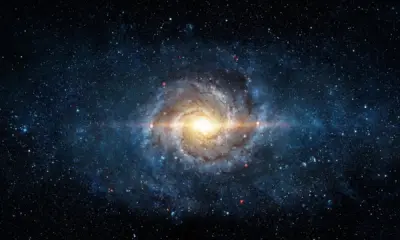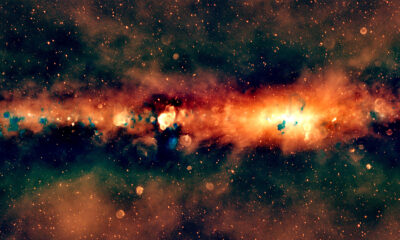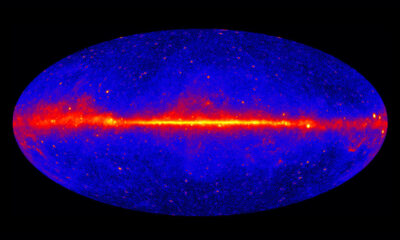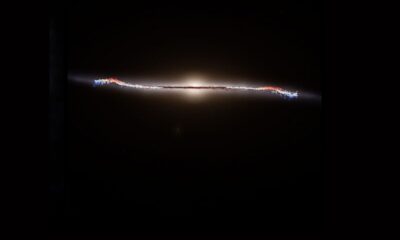Science
Astronomers Track Elusive “Wandering” Black Holes in Dwarf Galaxies

Identifying black holes at the center of dwarf galaxies presents significant challenges for astronomers. A recent study led by Megan Sturm from Montana State University has provided insights into these “wandering” black holes, which often do not reside in the expected central locations of their galaxies. The research analyzed data from the Chandra Observatory and the Hubble Space Telescope on twelve potential Active Galactic Nuclei (AGN) candidates, confirming only three black holes and underscoring the difficulties in detecting these cosmic giants.
The study’s significance lies in the role black holes play in galactic evolution. Early black holes could serve as the “seeds” for galaxies, influencing their formation and growth. Unlike large galaxies such as the Milky Way, which have experienced numerous mergers that obscure their black hole histories, dwarf galaxies maintain a clearer record of their origins, making them valuable for understanding early universe conditions.
Understanding the “Wandering” Phenomenon
Research indicates that up to 50% of the central black holes in dwarf galaxies may be displaced from their centers. This wandering can occur due to gravitational “kicks” resulting from mergers, or it may stem from their formation processes. A black hole could have formed in a gas cloud that was never at the galaxy’s center, leading to a scenario where surrounding matter has not adjusted to its gravitational influence.
To investigate these wandering giants, Sturm and her colleagues focused on twelve dwarf galaxies selected from a larger list of 111 candidates identified using the Very Large Array. These galaxies emitted radio signals characteristic of accreting black holes, although similar signals can also originate from standard star formation processes. The authors aimed to clarify the source of these signals and confirm or refute the presence of black holes.
From the twelve candidates, they confirmed three using “multi-wavelength evidence” across radio, X-ray, and optical wavelengths. One of the confirmed candidates, designated as “ID 26,” stood out for being bright across all three wavelengths. Another candidate, “ID 82,” was detected only in X-rays, suggesting its optical signals may be obscured by gas and dust. The third candidate, “ID 83,” exhibited strong X-ray emissions and optical characteristics consistent with a black hole.
Dissecting False Positives and Future Research
The research also identified two misleading sources that initially appeared to be AGNs. Candidate “ID 64” had a bright optical source that was later determined to be a background galaxy, while “ID 92” turned out to be linked to a highly active star-forming region rather than an AGN. These findings highlight the complexities involved in black hole detection in dwarf galaxies.
The study left seven radio sources without clear identification, suggesting potential background sources. Among these, candidate “ID 65” may be connected to a Fast Radio Burst (FRB), a phenomenon whose origins remain under investigation. The authors propose that further observations using more advanced telescopes, such as the James Webb Space Telescope, could yield more information on these elusive black holes.
As the scientific community awaits decisions regarding telescope time allocations for the upcoming observational cycle, the findings from this research represent a significant step toward unraveling the mysteries surrounding black holes and their role in the formation of galaxies. This ongoing exploration not only enhances our understanding of the cosmos but also connects to fundamental questions about the universe’s early stages.
-

 Technology4 months ago
Technology4 months agoDiscover the Top 10 Calorie Counting Apps of 2025
-

 Health2 months ago
Health2 months agoBella Hadid Shares Health Update After Treatment for Lyme Disease
-

 Health3 months ago
Health3 months agoErin Bates Shares Recovery Update Following Sepsis Complications
-

 Technology3 weeks ago
Technology3 weeks agoDiscover 2025’s Top GPUs for Exceptional 4K Gaming Performance
-

 Technology4 months ago
Technology4 months agoDiscover How to Reverse Image Search Using ChatGPT Effortlessly
-

 Technology2 months ago
Technology2 months agoElectric Moto Influencer Surronster Arrested in Tijuana
-

 Technology4 months ago
Technology4 months agoMeta Initiates $60B AI Data Center Expansion, Starting in Ohio
-

 Technology4 months ago
Technology4 months agoRecovering a Suspended TikTok Account: A Step-by-Step Guide
-

 Health4 months ago
Health4 months agoTested: Rab Firewall Mountain Jacket Survives Harsh Conditions
-

 Lifestyle4 months ago
Lifestyle4 months agoBelton Family Reunites After Daughter Survives Hill Country Floods
-

 Technology3 months ago
Technology3 months agoUncovering the Top Five Most Challenging Motorcycles to Ride
-

 Technology4 weeks ago
Technology4 weeks agoDiscover the Best Wireless Earbuds for Every Lifestyle





















